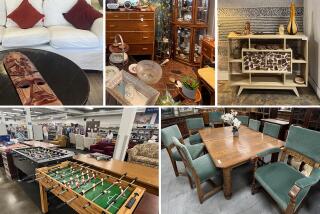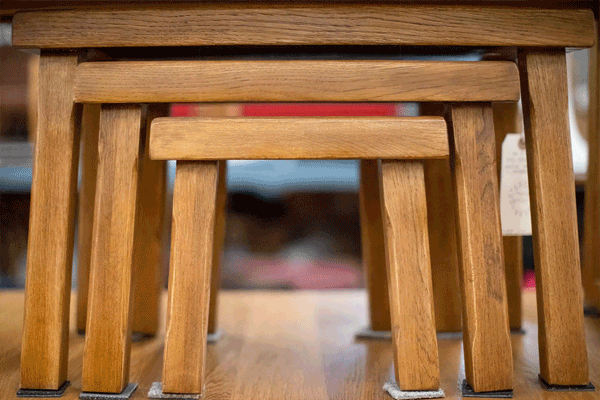It’s Monterey, Jack : Will Rogers loved it. Clark Gable and Edward G. Robinson did too. Now everyone wants this Old West furniture.
- Share via
Devotees dig around flea markets and swap meets, hunting for pieces of California’s past. “People are absolutely haunted by this stuff. You can see it at the swap meets,” says Pamela Lansden, a Los Angeles journalist and set decorator. “It’s a throwback to sweeter, more innocent times.
“If there was a Toon Town ranch, it would be decorated in Monterey,” says Lansden. “I don’t know if people who collect Queen Anne have a great emotional attachment, but people who collect Monterey do. Your heart is melted by it.”
She is among a passionate and growing group of collectors who are rediscovering the line and the look. In 1929, Mason Manufacturing Co. on East 60th Street in Los Angeles, originally known for its ironwork and iron lamps, began designing and handcrafting the 120-piece Monterey line. The wooden sofas, chairs, desks, secretaries, dining room and bedroom sets and wrought-iron accessories had the aura of western movie sets of the era. No wonder, according to 89-year-old George Mason, the man responsible for designing the line and son of co-owner Frank Mason, the first settee replicated a piece in a Warner Bros. movie.
The look may have a prop persona, but each piece was quality built, handmade of Oregon alder, carved, bruised, buffed, then finished to look very old for the very new Spanish Revival and ranch homes that were filling Los Angeles and Hollywood in the ‘30s. Along with Spanish Revival architecture came California’s Monterey architecture, a combination of Spanish and American Colonial design. Hungry for decor that reflected the region and its heritage, customers found the wood furniture with wrought-iron hinges and straps, rope seat supports and hand-painted wildflower and desert scenes perfect for their nouveau California abodes.
Mason found his inspiration in California’s Western and Spanish past, then added a dose of Hollywood. Mason, who now lives in Santa Cruz, says he particularly enjoyed studying the Catholic mission architecture and decor. Many of the design roots are from the Arts and Crafts movement. If the line’s ancestry is a genealogical hodgepodge, the result is a look both fitting and festive.
Distributed through Barker Brothers and other major department stores across the country, business boomed for only a while--one of the reasons Monterey is so collectible today. Frank Mason died in 1943, George was drafted into the Navy, and the factory was sold in 1945. By the early 1960s, the bloom began to fade on the hand-painted floral designs, and pieces were abandoned or stripped, refinished or painted by a generation tired of their parents’ “kitschy,” chubby furniture.
*
When extant collections were found, it took a special person to appreciate them. In 1959, Jack Emrek and his wife, actress Sue Ane Langdon, bought a 1929 Monterey-style apartment building that was filled with Monterey furniture. “We thought it was cute and fit the apartment so well,” says Emrek. They began picking up pieces at auctions and putting sets together. But it wasn’t until 1980, when they spotted a straw-colored, hand-painted dresser (price: $2,800) in a Santa Monica shop window that they realized how prized their collection was becoming.
They no longer own the apartment building, but the Emreks’ Calabasas-area ranch is brimming with Monterey furniture. Their passion goes beyond wood and paint to the people who were first smitten with Monterey. Walt Disney, Roy Rogers, Clark Gable, Edward G. Robinson, Will Rogers, Bela Lugosi, Gene Autry and Harry Carey Sr. all decorated with Monterey. Today, the Harry Carey Jr. family, Diane Keaton, and Joel Shukovsky and Diane English are Monterey furniture fans.
In the late 1970s, Don Shorts and his wife, Delores Fisher, known as the pioneers of Monterey furniture dealing, started picking up small items at swap meets--”mainly because they made us smile,” Shorts says of those early novelty purchases. “Later, when we started seeing earlier pieces from the classic period, we were quite amazed. We didn’t dream that such beautiful examples existed.” Today, their Old California Store in Ventura features Monterey furniture and exquisite pottery pieces of the era, as does their home that shares the space.
The boomlet picked up momentum in 1988, when the Santa Monica Heritage Museum mounted the show “Monterey: California, Rancho Furniture, Pottery and Art.” Shorts and Fisher were guest curators. That show was a benchmark, and the once-orphaned pieces of Monterey found themselves in some of L.A.’s stylish homes. Interest in Western style of all sorts was mounting at about the same time.
Marty Frenkel, president of Rituals on North La Cienega Boulevard in Los Angeles, saw prices take off in 1992. “It was a well-kept secret of a small group of collectors. Now dealers are paying more, and flea market finds are hard to find,” says Frenkel. Prices in his inventory range from $400 to $10,000, but for collectors outgunned by big-bucks buyers in the Stickley and Roycroft field, Monterey is still affordable.
Many have seen Monterey furnishings in a place they were intended for: the Will Rogers ranch in Pacific Palisades.
In June 1996, Architectural Digest featured a story and photo spread on Monterey. Furniture that once filled Middle American homes was photographed like museum pieces.
“The prices have increased in the past 12 months; there is mass interest attributed to the article,” explains Roger Renick of Roger Renick Fine Arts & Antiques Gallery in Pasadena. “Now people have some reference; they can see examples. I pay two to three times what I used to so I can have it on the floor. Good examples are getting that much more difficult to find.”
Renick originally collected Arts and Crafts pieces, but his interest shifted to Monterey when he spotted a gentleman’s chest with straps. “I bought it for my wife for Christmas,” he says. That was seven years ago. Renick began researching Monterey furniture and “from there it never stopped.” The Renicks have 65 pieces in their personal collection and offer more than 20 pieces at the gallery.
Prices aren’t listed in antiques guides, and while prices vary, a sofa that originally sold in 1931 for $110 can now run from $5,000 to $7,000. The most prized pieces were made from 1929 through 1935. The original dark “old wood” stain was followed by “old red, straw ivory, Spanish green” and later blue with hand-painted details. In the mid-1930s, the company shifted to a Western motif using leather fittings, a “desert dust” finish and phased out some decorative ironwork. The final line featured an Early American style.
The most prized and difficult to find piece of Monterey furniture is the baby grand piano. The company purchased about 25 pianos of different brands, replaced the legs, hand finished and painted them and added ironwork. Other much sought-after treasures include radio cabinets, cellarettes (bar/buffet affairs popular during Prohibition) and tile-topped dining room buffets. Knockoffs of Monterey furniture include Coronado, La Fiesta and Ranch-O, all collectible, but not as sought-after as Monterey.
What makes the hunt so much fun is the scarcity and odd assortment of pieces. Besides the department store lines, George Mason designed individual pieces for clients and fanciful novelty items.
Those who love the workmanship of each piece also appreciate the quirkiness. They may be passionate, die-hard collectors in a field with fewer and more expensive finds, but when you get down to it, Monterey makes them happy. “If it doesn’t make you laugh, why buy it?” asks Lansden.
More to Read
Sign up for The Wild
We’ll help you find the best places to hike, bike and run, as well as the perfect silent spots for meditation and yoga.
You may occasionally receive promotional content from the Los Angeles Times.






